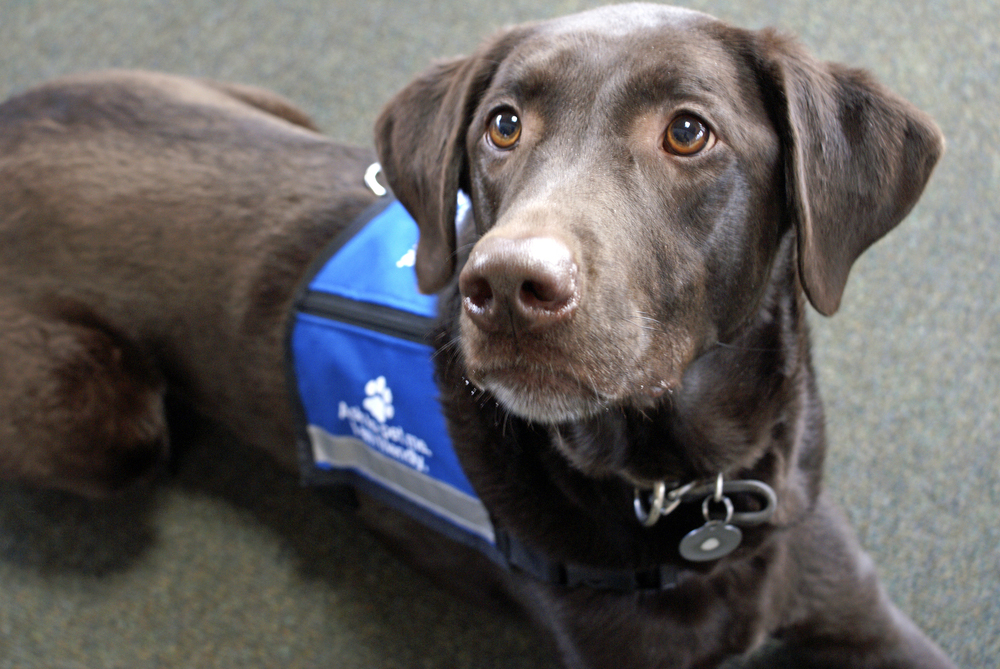To avoid a hairy situation, employers should familiarize themselves with laws relating to the emerging issue of animals at work. Most animals fall into the following three sets: (1) service animals, (2) comfort or therapy animals, and (3) pets.
Service Animals
The Americans with Disabilities Act (ADA) defines a service animal as a dog “individually trained to do work or perform tasks for the benefit of an individual with a disability, including a physical, sensory, psychiatric, intellectual, or other mental disability.” Any dog breed can be a service animal if it is trained for that purpose.
Although service animals are generally dogs, the ADA recognizes that specially trained miniature horses qualify as service animals in some cases. Service dogs (or miniature horses) may be trained to perform many tasks, including assisting people who are blind or deaf, helping individuals who have seizures, reminding someone to take medication, calming individuals with posttraumatic stress disorder (PTSD), or pulling an individual in a wheelchair. Service animals usually must be on a leash and must be housebroken.
Businesses, state and local governments, and nonprofit organizations that serve the public usually must allow service animals to accompany people with disabilities wherever the public is normally allowed to go under Title III of the ADA.
Title III prohibits discrimination based on disability in the activities of places of public accommodation. For instance, hospitals shouldn’t exclude a service animal from patient rooms, clinics, or the hospital cafeteria. But hospitals don’t need to allow service animals in operating rooms or burn units, where they could compromise a sterile environment.
When addressing a member of the public, staff can ask only two questions relating to service animals:
- Is the service dog required because of a disability?
- What work or task has the dog been trained to perform?
Staff cannot ask for other information or demand documentation for an animal to qualify as a service dog. Specifically, staff cannot ask anything about the individual’s disability. Additionally, service dogs aren’t required to wear vests or ID tags indicating they are service animals.
A facility may be able to exclude a service dog if it is a direct threat, but that is a high burden to meet. For example, dog allergies generally are not enough to keep the owner from entering a facility with a service dog. In extreme cases, a service dog can be a direct threat.
In Roe v. Providence Health System-Oregon, an Oregon court found that a St. Bernard named Cretia was a direct threat when the dog caused a “putrid odor to permeate the entire seventh floor” where a hospital patient was staying.
Cretia growled at hospital staff and caused them to develop skin rashes. The dog also had an infection, which doctors at the hospital believed would spread to other patients. Even though Cretia was a service dog, the hospital was allowed under the ADA to forbid her owner from bringing her into the hospital. The circumstances surrounding Cretia were highly unusual—most service dogs will not be a direct threat.
While Title III generally prohibits public accommodations from excluding service animals, Title I of the ADA, which deals with employment, doesn’t offer the same specific guidelines for employers to follow.
But you shouldn’t forget about your obligations under the ADA simply because Title I doesn’t explicitly mention service dogs. Under the ADA, you must provide reasonable accommodations for qualified employees with disabilities. But you don’t need to provide accommodations that would impose undue hardships on your business.
For example, if an employee with a disability approaches her employer requesting to bring in a service animal to help her perform a task, the ADA requires the employer to engage in an interactive process. That includes a dialogue with her to determine whether her request is reasonable or whether there is another reasonable accommodation it could make instead. It will likely want to inquire what kind of animal she seeks to bring in to work, whether the animal is aggressive, up-to-date on vaccinations, housebroken, and effectively controlled by the handler.
Comfort Animals
A comfort animal isn’t a “service animal” under the ADA. Instead of being trained to assist with a specific task or tasks, its presence provides psychological comfort. Comfort animals are also commonly referred to as emotional support animals or therapy animals.
Comfort animals are not covered by Title III. Therefore, businesses, state and local governments, and nonprofit organizations aren’t required to allow comfort animals to accompany their owners as a public accommodation.
But under Title I, employers may still be required to allow employees with disabilities to bring a comfort animal to work as an accommodation. If an employee approaches you requesting to bring in a comfort animal to assist with stress and anxiety, you should still engage in the interactive process with her, even though the animal isn’t a service dog.
Pets
The American Society for the Prevention of Cruelty to Animals (ASPCA) estimates 44%of all households in the United States own a dog—with a total of 78 million pet dogs! A growing number of employees, including some employees at Google and Amazon, may bring pet dogs to work.
You should consider the potential legal implications if a dog injures a person or property. Employers wanting to allow employees to bring their pets to work should adopt clear policies and discuss the change with their insurance carriers.
Sarah Otto practices employment law with the firm Foulston Siefkin LLP. She can be reached at sotto@foulston.com.

